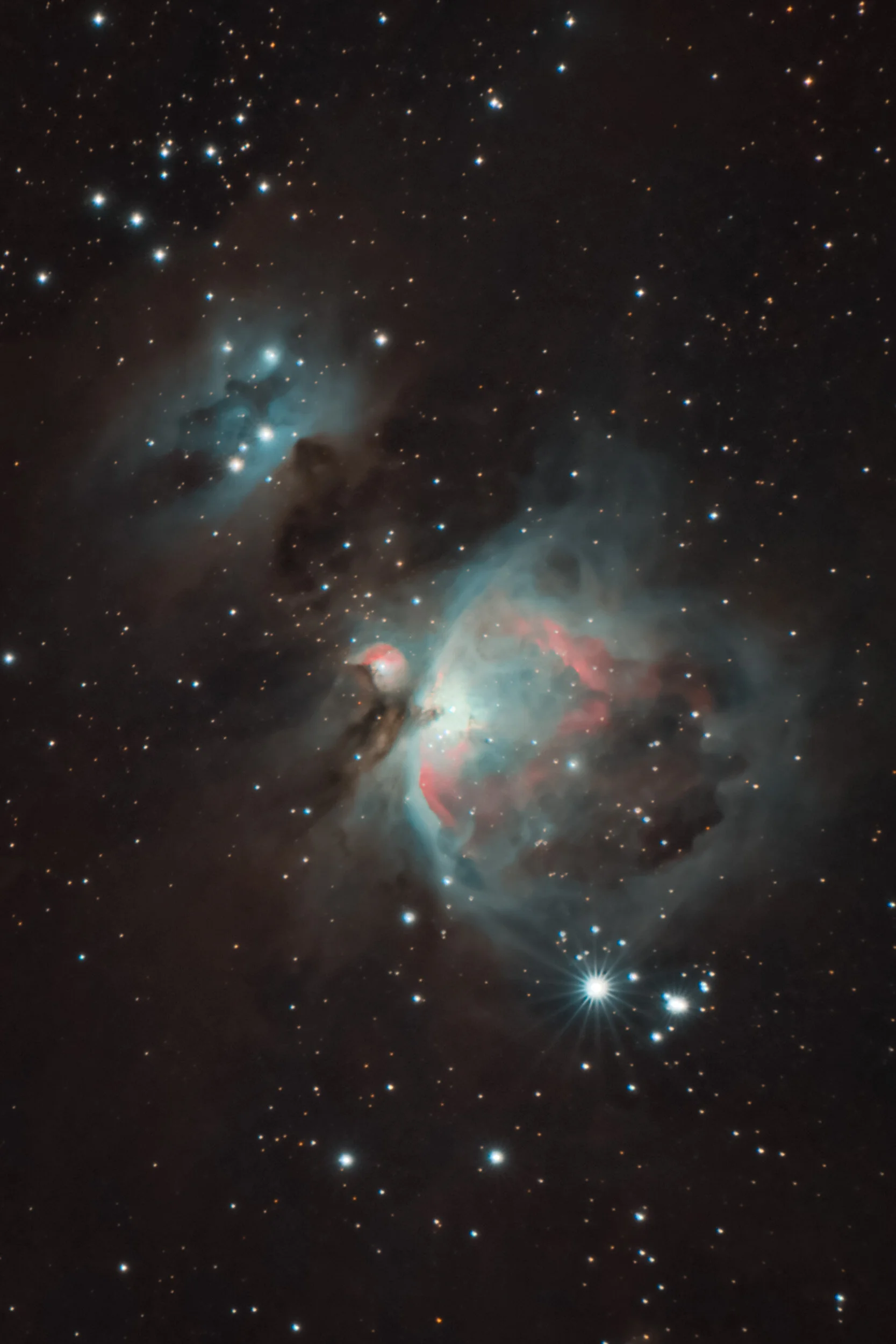The Night Sky - Episode 3
The Orion Nebula
Here’s a look at a fascinating region of the night sky - the Orion constellation and in particular, the Orion Nebula. Watch the video below to learn how to locate the Orion Nebula in our night sky and see a close-up view. And scroll on to read more about the constellation and the nebula.
This is episode 3 in my series on our night sky. View episode 2 here.
The Orion Nebula (sometimes referred to as The Great Orion Nebula) is also known by its other designations - Messier 42 (M42) and NGC 1976. It is located in the constellation of Orion in our own galaxy, the Milky Way.
Here is an image of the Orion Nebula.
Image created using a Canon 6DMarkII camera at a focal length of 300mm, f/7.1, ISO 6400.
Two sets of image exposures were taken. One set of 550 images each of 15 seconds was taken to capture the nebula itself. The second set was 200 images each of 3 seconds to capture the very bright core of the nebula. In all about 2.5 hours’ worth of data was captured and stacked to generate this image.
The Orion Nebula is the brightest nebula in our night sky and the only one visible to the naked eye. We can see it as a fuzzy patch under very dark skies with low levels of light pollution. It is at a distance of ~1340 light-years from the Earth. This means that what we see of the nebula today is what it actually looked like around 600A.D.! The nebula is the closest region of massive star formation to the Earth with hundreds of stars being born in its depths. One estimate puts the number of new stars being born there to be between 700 and 1000.
To understand where to find the Orion Nebula, we must first look for the Orion constellation.
Ultra-wide field of view of the night sky during the winter months in the Northern hemisphere. This is seen when facing East-Southeast.
Image is at 14mm field-of-view.
Orion is probably the most recognizable constellation in the night sky. It can be seen during the autumn and winter months in the Northern hemisphere, situated in the southern skies. Three relatively bright stars, Alnitak, Alnilam and Mintaka, form a straight line representing the “belt” around Orion’s waist. Once we find the belt, we can quickly find the other stars that form the main outline of this constellation. See if you can visualize Orion’s belt in the unmarked image above.
Orion is an ancient constellation, known to the early Greeks, Romans, Indians, Egyptians, Navajo people and other cultures. We get the modern name of the constellation from the ancient Greeks and Romans who named the star pattern after a legendary hunter in their mythology. The ancient Indians had a different name for it — Kaalpurush — a representation of the god Vishnu. The Navajo named these stars Atse Ats'oosi, and marked its passage across the sky to plan their planting and harvesting seasons.
While the human eye can only see the stars shining like tiny diamonds against the black velvet curtain of the night sky, there are in fact numerous other objects deep in space that can be seen with the help of technology. Using any digital camera from the last 20 years or so, we can capture more of the faint light reaching us from outer space. The sequence of images below shows what actually exists in the region of the night sky containing the Orion constellation if we capture sufficiently long durations of light.
By capturing light over extended periods of time, we can bring out the faint details of the night sky.
The first image in this sequence is a single 60-second exposure. It roughly equates to what the human eye would see
The second image in this sequence is a combination of 169 exposures of 60 seconds each for a total of ~2.8 hours of light. The enhanced amount of light captured makes it easy to see the actual colours of the stars in Orion (red and blue-white supergiants) and various regions of nebulosity.
Image is at 70mm field-of-view.
The general region around the constellation is known as the Orion Molecular Cloud Complex and it contains a number of nebulae, star clusters and other deep-space objects. Below is an annotated version of the complex.
Various stars and other deep-space objects located within the boundaries of the Orion constellation. The Orion Nebula is seen as the middle star of Orion’s dagger hanging below his belt.
Image is at 70mm field-of-view.
Now that we know where to find the Orion Nebula in the night sky, let’s take a closer look at it. The image below shows an annotated version of the Orion Nebula.
The Orion Nebula and surrounding areas.
Image is at 300mm field-of-view.
The Orion Nebula (M42) is centred around the middle star (θ Orionis) in Orion’s dagger. In fact, what we perceive as a single star with our naked eye is actually a cluster of stars and the surrounding nebulosity that is part of M42. The nebula is massive, more than 24 light-years across. This means that if you were to start travelling at one edge at the speed of light, it would still take you 24 years to get to the other edge!
Beside it are two smaller nebulae. NGC 1977, nicknamed the Running Man Nebula (because it looks like a man running away from something), is a reflection nebula that consists of ionized atomic Hydrogen. And M43, also known as De Marian’s Nebula is a region of active star formation.
The colours in the nebula tell us about the composition of various regions.
The colours in the nebula indicate the composition of various regions.
Image is at 300mm field-of-view.
The reds point to regions of emitted Hydrogen-alpha (Hα) radiation. Hα is a specific deep-red visible spectral line with a wavelength of 656.28nm. It is important in astronomy as it is emitted by many emission nebulae. The blues point to reflected radiation from massive O-class stars. Such stars are huge, more than 15 times the mass of our own Sun and burning 5-6 times hotter. The greens point to regions with doubly ionized Oxygen, a type of radiation that needs the high vacuum of deep-space to be produced.
Observing the night sky is infinitely more interesting when we know what we are looking at. So the next time you're under a dark night sky, look up, find Orion's dagger and try to catch a glimpse of this magnificent little jewel — The Orion Nebula.







